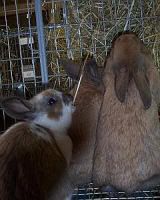by Laurie Stroupe
I am not a vet. Before treating your rabbit, you should consult your own vet. I am sharing my understanding and beliefs as a rabbit breeder. Please confirm any information through other resources before relying on them.
The Basics of Rabbits’ Digestive Systems
 A rabbit’s digestive tract is built for a diet low in carbohydrate, low in protein, and very high in fiber (18%+). The digestive system should be moving constantly at a rapid pace. Through a complicated and delicately balanced system, food is sterilized in the stomach and then passes through the small intestines. Larger particles are moved into the large intestine and processed into those large round pellets we are familiar with. Smaller particles of cellulose are moved into the cecum, where they are fermented. Certain vitamins are produced in the cecum. Cecotrophes are small, soft clusters of smelly excrement, which the rabbit consumes in order to benefit from the vitamins which must be produced since they are not present in their native diet.
A rabbit’s digestive tract is built for a diet low in carbohydrate, low in protein, and very high in fiber (18%+). The digestive system should be moving constantly at a rapid pace. Through a complicated and delicately balanced system, food is sterilized in the stomach and then passes through the small intestines. Larger particles are moved into the large intestine and processed into those large round pellets we are familiar with. Smaller particles of cellulose are moved into the cecum, where they are fermented. Certain vitamins are produced in the cecum. Cecotrophes are small, soft clusters of smelly excrement, which the rabbit consumes in order to benefit from the vitamins which must be produced since they are not present in their native diet.
In The Beginning
Rabbits are born with a different PH level in their stomachs than adult rabbits. They also do not produce cecotrophes right away. Around two weeks of age, they have the ability to consume cecal matter from their dam. They begin producing their own cecotrophes around three weeks of age. By that time their own stomach PH level has changed. It is the first challenge that their digestive system meets and some young rabbits do not handle the change well. Some will die at this stage. See our article on baby rabbit digestive systems.
Keep It Moving to Prevent GI Stasis
The number one goal, I believe, in a rabbit’s diet is to keep the system moving. When the gut becomes sluggish, it is susceptible to fur blockage or blockages caused by hard food balls. It was previously thought that ingesting fur caused these blockages, but current thought is that a slowdown of the digestive system allows the blockages to form.
GI Stasis is the extreme slowdown of the system, possibly to a standstill. Here is an excellent external article on GI Stasis.
When a rabbit isn’t feeling well, we may first notice their lack of eating and drinking. Probably even more important is to watch their production of cecal and fecal matter. One of the first signs that the system is out of balance is the production of excessive cecal matter and/or the reduction of fecal matter, even to cessation.
Hay Matters for All Rabbits: Pet, Show, Meat, and Brood Stock

Yes, I am a big believer in hay. My rabbits have hay available nearly constantly. Hay is cheap, full of fiber, and provides rabbits with chewing opportunities that fight obesity, help to wear the teeth, and help rabbits deal with boredom and stress. Hay need not provide nutrition. It’s simply in the diet for roughage. It’s biggest benefit is that it keeps the digestive system moving. I believe that unlimited hay also balances the higher protein diets that we wish to feed our rabbits for better flesh condition. And it allows us to safely add a small amount of grain or other conditioner. Without the extra fiber, too much protein or carbohydrate can send the digestive system out of balance.
How Much Protein in the Diet?
I’ve seen authorities say that 14% was the correct level of protein for a rabbit’s diet. Another says that less than 16% is appropriate. But most breeders use between 16% and 18%, I believe. We are looking to optimize the flesh condition of our rabbits.
Hollands are a delicate breed in a delicate species. They do not tolerate excessive protein and carbohydrates as well as other breeds even. It may be that way with other fancy breeds as well. I have fed my Hollands 16% protein with success. When I moved to Blue Seal Show Hutch Deluxe, which is 17% protein in an extruded pellet, I was very nervous. But I think that I am having success with it because I am such a huge hay feeder and because the feed has a probiotic in the formula, which helps keep the digestive system in balance. I would not feed my Hollands a 17% protein regular feed.
If you find that your rabbits are having bright orange urine over a period of time, it may be that your rabbits are eliminating undigested protein, by the way.
Signs a Rabbit is Feeling Sick
Unfortunately, when things go wrong in a rabbit’s digestive system, you may not have much time to correct the problem. I’ve seen rabbits go from no symptoms to dead in less than 24 hours.
The first thing to do is pay attention when you notice a rabbit has not eaten as you would expect. Sure, when the weather gets hot, they all eat a little less. You may notice reduced appetites after you worm your herd. But when a rabbit that normally clears his dish leaves some, it’s time to take him out and check him over. Pay special attention to him. Usually, it’s nothing. But even twelve hours of anorexia in a rabbit can be problematic.
If you see any of the following, it’s time to take action:
- sticky bottom – excessive cecal matter stuck to his bottom
- excessive cecotrophes on the cage floor
- blood or mucous in the feces
- teeth grinding
- very noisy gut sounds or no gut sounds
- not drinking water
- few or no new droppings
- diarrhea
- bloating, full of gas
- noticeable loss of weight and condition – a sunken look
- the coat has gotten very rough suddenly
- lethargy
- swellings in the mouth
- malocclusion that prevents normal feeding
- a mass in the gut – feels like a two-week pregnancy – even in a buck
- no food consumption for twelve hours
GI Stasis: When Nothing Is Going On
 If there’s no diarrhea, blood, or mucous, but there’s little bowel movement and signs of pain (teeth grinding), a mass in the gut, and/or abnormal gut noises, your rabbit’s digestive system may have ground to a halt. This is called GI Stasis; when nothing is going on. And you need to act fast.
If there’s no diarrhea, blood, or mucous, but there’s little bowel movement and signs of pain (teeth grinding), a mass in the gut, and/or abnormal gut noises, your rabbit’s digestive system may have ground to a halt. This is called GI Stasis; when nothing is going on. And you need to act fast.
You have two main goals right away: keep the rabbit hydrated and get the gut moving.
Here are some things you can try:
- Fresh pineapple juice, 10 ml up to three times per day
- V-8 juice
- Pedialyte
- probiotic (benebac gel, Fast Track liquid dispersible, Acid Pak, etc.)
- a mixture of equal parts fluid (juice, Pedialyte, probiotic treated water), vegetable baby food or canned pumpkin, and pellets (use fines, grind the pellets, or let the mixture sit for 25 minutes) fed by syringe. NOTE: never point a syringe toward the throat – administer sideways in the mouth toward a cheek
- infant gas drops
- abdominal massage
- fresh herbs
- raspberry or blackberry leaves
- kale, spinach, or carrot tops
- Lactated Ringer’s given subcutaneously (consult your vet)
I do not include hairball remedies on purpose. Generally any hairball is secondary to the original problem. And, it may coat the food ball with oil, making it even harder to hydrate, which is necessary for it to break up. Some breeders have reported success with them, however. Again, you still want to address the gut motility problem that allowed the obstruction to form in the first place.
Diarrhea
 The first thing to do is decide whether your rabbit really has diarrhea. Most likely, you are seeing excessive cecal matter. Diarrhea is watery or runny without form and may contain mucous and/or blood. It is more rare in rabbits. Cecal matter looks like tiny clusters of grapes. If it is excessive cecal matter you are dealing with, eliminate all treats and conditioners right away. If that doesn’t do the trick, reduce the diet to hay and water. Then, when the excessive cecal matter disappears, add back pellets. You can then add back conditioners and treats one by one, backing off if you see the excessive cecal matter reappear.
The first thing to do is decide whether your rabbit really has diarrhea. Most likely, you are seeing excessive cecal matter. Diarrhea is watery or runny without form and may contain mucous and/or blood. It is more rare in rabbits. Cecal matter looks like tiny clusters of grapes. If it is excessive cecal matter you are dealing with, eliminate all treats and conditioners right away. If that doesn’t do the trick, reduce the diet to hay and water. Then, when the excessive cecal matter disappears, add back pellets. You can then add back conditioners and treats one by one, backing off if you see the excessive cecal matter reappear.
But what if your rabbit really has diarrhea? The main goal here is to re-hydrate the rabbit. Again, you can use Lactated Ringer’s if your vet is willing to sell them to you. I give mine by subcutaneous injection in the neck skin behind the head rather than purchasing the set up for IV drip. Another good choice is an electrolyte solution (Pedialyte) given orally by syringe, if necessary. If you do not have quick access to an electrolyte solution, you can make an oral re-hydration therapy solution at home (ORT). There are numerous recipes available on the internet. Here’s one I’ve used with success:
1 cup clean water
2 teaspoons sugar
1/4 teaspoon baking soda
3/16 teaspoon salt (take some out of a 1/4 tsp. or use a rounded 1/8 tsp.)
This recipe has been posted on my website for awhile and several people have written me to say they’ve used it with success.
Unfortunately, diarrhea is a symptom in many rabbit conditions. However, coccidia is the most common parasite in rabbits and is as good a guess as anything else. Treating for dehydration and treating for coccidia will cover the odds the best. Many breeders use Corrid powder for treating coccidia. I’ve only done it once. But it seemed to stop the outbreak of diarrhea and deaths within a particular litter.
I have read the dosage of 1 tsp. of Corrid powder per gallon of water and then use it to replace the rabbits’ regular drinking water. I have not been able to confirm that through a veterinary resource, however.
By the way, milder infections of coccidia may not cause diarrhea but just cause a rabbit to fail to thrive.
An Ounce Of Prevention
Feed hay liberally. Choose a feed that has the appropriate level of protein for your breed (and perhaps the lines within that breed that you work with). Limit carbohydrate treats and conditioners. I no longer use oats in my barn and have seen a huge reduction in deaths due to diarrhea. Use vegetables and the occasional small portion of fruit as treats. Observe each rabbit each day, handling as many as possible. Keep Pedialyte, baby food, feeding syringes, baby gas drops, and Lactated Ringer’s (if your vet will sell them to you) on hand. Purchase a stethoscope so that you can listen for gut sounds.
Next Article: Taking a look at the digestive tract of baby and weanling rabbits

